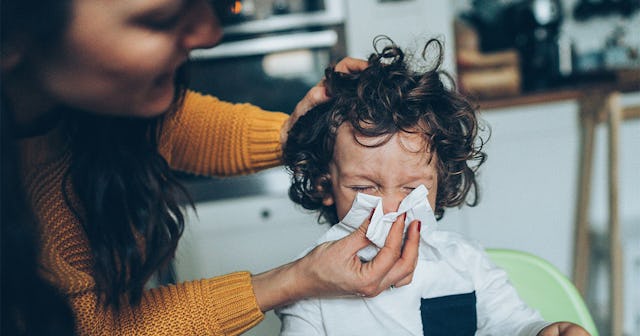Kids With Long Haul COVID Need Accommodations At School

A few weeks ago, millions of kids returned to the classroom, many for the first time in a year and a half. The return came as schools figure out how best to keep kids safe among a virus that’s still running rampant. (If I were one to point fingers, I’d point one at the Delta variant and another at anti-vaxxers, but as I’m not a finger pointer, I’ll forego spending time on who’s to blame.)
The logistics of that return are complicated. Schools are grappling with mask wearing, social distancing, quarantining students who’ve been exposed, providing virtual learning in some cases, and often dealing with a portion of the community that’s angry about all of it.
Unfortunately, one element of students’ return to school has been, so far, largely left out of the conversation. That is how to support students with long-haul COVID. Many districts are at a loss and don’t fully know how to help. Also, all of this is still fairly new, so forging a path forward is complicated.
Long COVID Is More Common In Kids Than We Thought
When COVID first arrived at our doorstep, the message to parents was comforting (if anything about those early days was comforting). It was this: don’t panic. COVID doesn’t affect kids.
As it turns out, that’s not quite accurate. It wasn’t then, and it’s definitely not now. More than 5.7 million kids have tested positive for COVID, according to the American Academy of Pediatrics. Of those 5.7 million, studies have indicated that between 11 and 15 percent of infected children might suffer from Long COVID—a post-infection syndrome wherein someone experiences lingering symptoms. In kids, the symptoms most often include fatigue, shortness of breath, headache, brain fog, and loss of taste and smell. They can be debilitating and life-altering.
Experts have not yet identified why some kids suffer for weeks and months while others do not. Nor have they found a treatment that works for all kids and adults affected.
Long COVID at School
ljubaphoto/Getty
Now that millions of kids across the country are back in school, the impact of Long COVID on kids is becoming more obvious. School closures and difficulty accessing, navigating, or focusing during remote school caused untold numbers of kids to fall behind. Long-haulers like eleven-year-old Chloe, who’s experiencing dizziness, fatigue, nausea, and headaches, or nine-year-old Harli, whose symptoms kept her from participating in remote and in-person class, are at risk of falling even further behind.
Experts are sounding the alarm.
“The potential impact is huge,” said Dr. Avindra Nath, chief of infections of the nervous system at the National Institute of Neurological Disorders and Stroke. “I mean, they’re in their formative years. Once you start falling behind, it’s very hard because the kids lose their own self-confidence too. It’s a downward spiral.”
Federal Disability Guidelines in School
Over the summer, President Biden announced that Long COVID could quality as a disability under federal guidelines. The Department of Education followed that announcement by releasing guidance to help schools and students navigate when a child is eligible for accommodations. Some may need extra time for test taking or more time to get to class. Others may need extra 1:1 support from a paraeducator or access to comprehensive distance-learning options.
Unfortunately, as with everything COVID related, it’s not as simple as we’d like it to be.
For instance, we don’t know whether long COVID is permanent or temporary. Early studies suggest half of children will have symptoms that resolve within three months. The other half will likely have symptoms that linger. “We don’t know how long. There is so little data,” notes Sarah Wulf Hanson, a research scientist at the Institute for Health Metrics and Evaluation at the University of Washington.
As a result, schools are going to have to continually monitor students’ needs. That requires a lot of resources that are already taxed to the limit in schools navigating the pandemic.
Kris Scardamalia, a professor at the University of Maryland School of Medicine and former school psychologist, highlighted the problem in an interview with The Washington Post. “Schools are going to need a lot of time and space for problem-solving,” she said. “And we’re going to have to go student by student.”
Parents will also have to be vigilant, warns federal civil rights and disability rights attorney Aaron Bates in an interview. Not only because getting equitable access can be an uphill battle for parents in the best of times, but because schools are already overwhelmed with the logistics of running a school during a pandemic.
Vaccines To The Rescue
gorodenkoff/Getty
In news that won’t surprise anyone who’s been paying attention, vaccines are the key both to slowing down the pandemic and preventing even more children from suffering from Long COVID and its consequences.
Wulf Hanson highlighted a new study that suggested vaccination could cut the risk of getting Long COVID in half for adults who experience breakthrough infections. (Here’s hoping the results of this study translate to children, as well!)
Unfortunately, as of this writing, children younger than twelve aren’t eligible for the vaccine in the United States. That may soon change. In the meantime, school districts are woefully unprepared to support kids suffering from Long COVID. That’s just another reason to remember to wear your mask, social distance as much as possible, and get vaccinated as soon as its available.
This article was originally published on